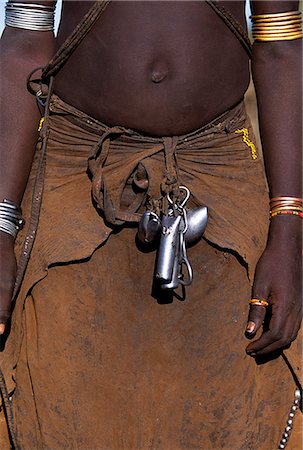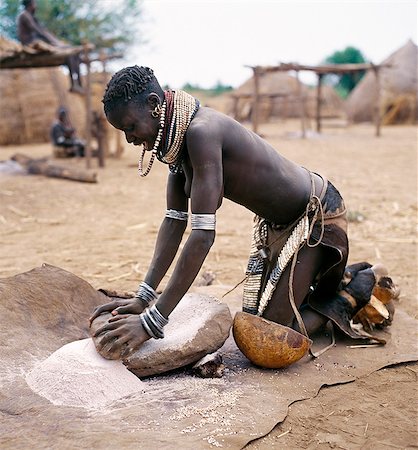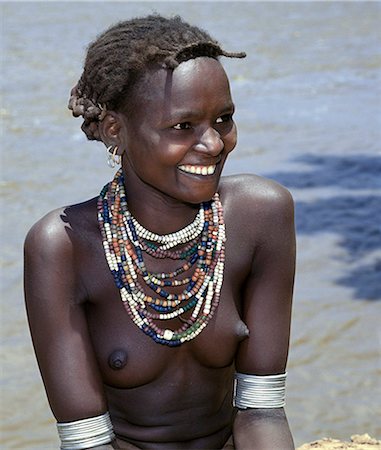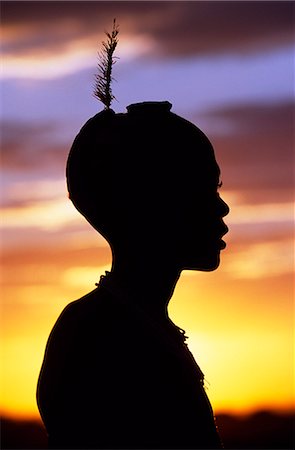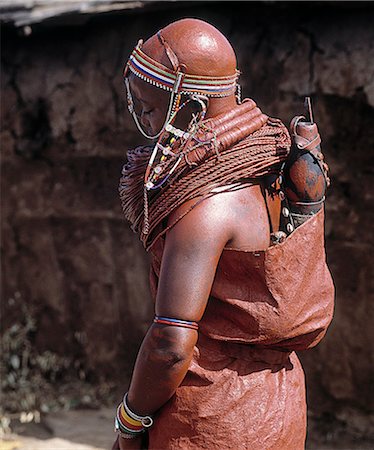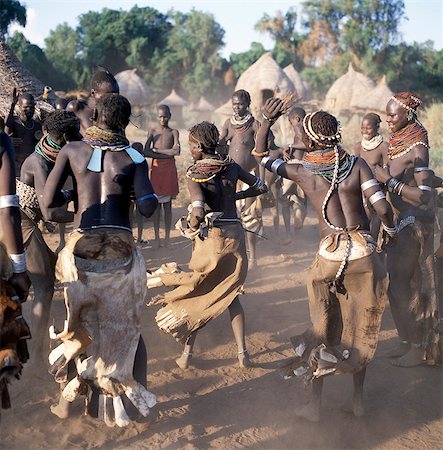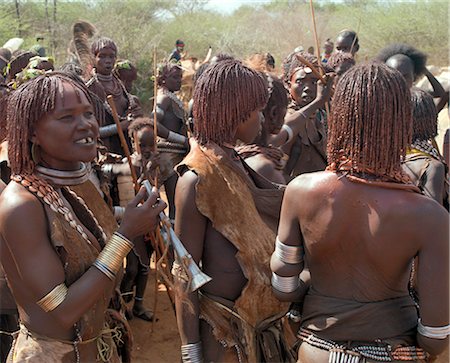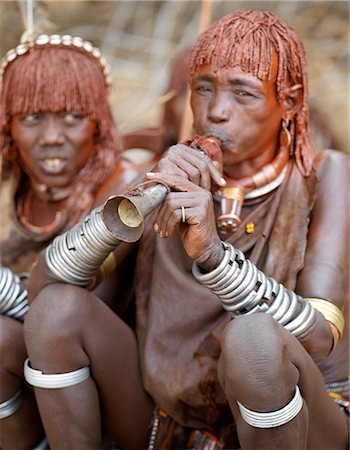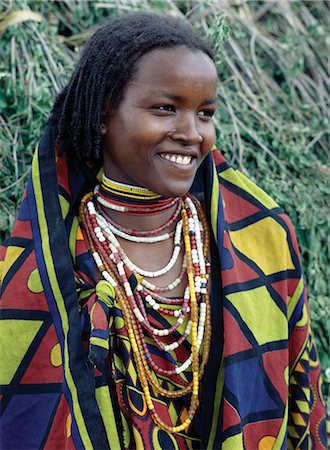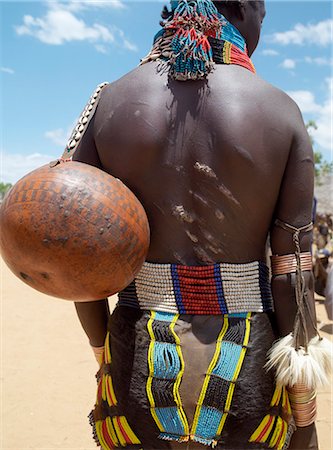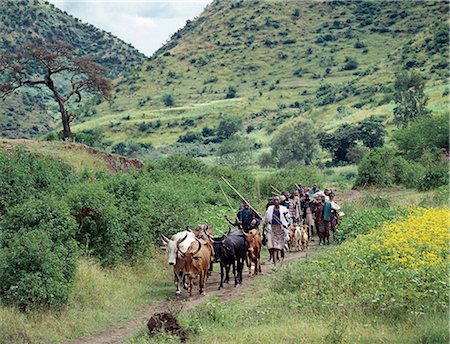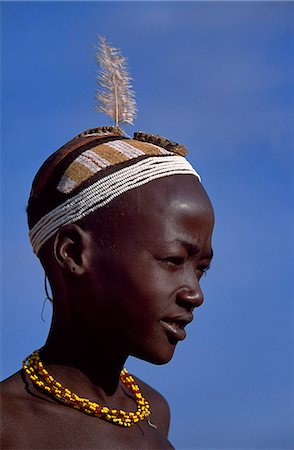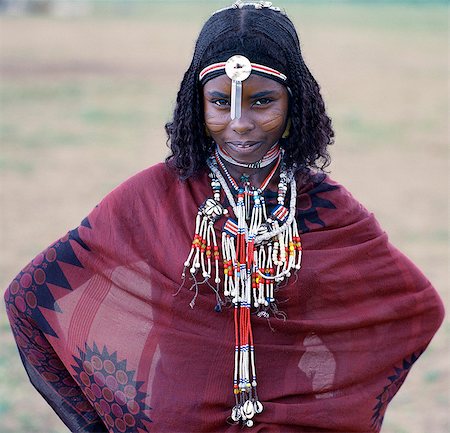-
A Dassanech woman milks a cow by hand collecting the milk in a gourd at a settlement alongside the Omo River. Much the largest of the tribes in the Omo Valley numbering around 50,000,the Dassanech (also known as the Galeb,Changila or Merille) are Nilotic pastoralists and agriculturalists.
Rights-Managed
-
A Nyangatom woman wears multiple layers of beads in necklaces, an elaborately beaded calfskin skirt and metal bracelets, amulets and anklets. She is standing beside a temporary beehive construction of sticks, grass and leaves built to provide shade for her goats. The Nyangatom or Bume are a Nilotic tribe of semi-nomadic pastoralists who live along the banks of the Omo River in south western Ethio
Rights-Managed
-
A Dassanech woman winnows grain by pouring it from her metal tin and letting it fall onto a calfskin. Much the largest of the tribes in the Omo Valley numbering around 50,000,the Dassanech (also known as the Galeb,Changila or Merille) and Nilotic pastoralists and agriculturalists.
Rights-Managed
-
An old Dassanech woman prepares her fields beside the Omo River with a digging stick in readiness to plant sorghum. This crude form of agricultural implement is in common use in this remote part of Ethiopia.
Rights-Managed
-
Two young Dassanech boys sport elaborate clay hairdos at their settlement alongside the Omo River. Much the largest of the tribes in the Omo Valley numbering around 50,000,the Dassanech (also known as the Galeb,Changila or Merille) are Nilotic pastoralists and agriculturalists.
Rights-Managed
-
A tourist accompanied by a retinue of children in a Dassanech settlement along the lower Omo River. Much the largest of the tribes in the Omo Valley numbering around 50,000,the Dassanech (also known as the Galeb,Changila or Merille) and Nilotic pastoralists and agriculturalists.
Rights-Managed
-
A tourist accompanied by a retinue of children in a Dassanech settlement along the lower Omo River. Much the largest of the tribes in the Omo Valley numbering around 50,000,the Dassanech (also known as the Galeb,Changila or Merille) and Nilotic pastoralists and agriculturalists.
Rights-Managed
-
A Karo woman with her face painted in preparation for a dance in the village of Duss. A small Omotic tribe related to the Hamar, who live along the banks of the Omo River in southwestern Ethiopia, the Karo are renowned for their elaborate body painting using white chalk, crushed rock and other natural pigments. She is wearing a goatskin apron and carries a leather belt decorated with cowrie shells
Rights-Managed
-
A Karo women stands in the doorway to her hut in the village of Duss. A small Omotic tribe related to the Hamar, who live along the banks of the Omo River in southwestern Ethiopia, the Karo are renowned for their elaborate body painting using white chalk, crushed rock and other natural pigments. In addition to painting her face she has decorated her body with whorls of goat hair tied by leather co
Rights-Managed
-
A young Nyangatom woman carries her baby on her hip in an elaborately braided papoose. Her hair has been reddened with a mixture of ochre and animal fat. Typical of her tribe, she wears a calfskin skirt, multiple layers of bead necklaces and metal bracelets and amulets. The Nyangatom or Bume are a Nilotic tribe of semi nomadic pastoralists who live along the banks of the Omo River in south western
Rights-Managed
-
A Nyangatom woman stands with her baby on her hip beside her grass hut in his temporary camp. Nyangatom married women wear elaborately beaded skirts which reach the ground at the back and often have panels of different coloured calkfskin sewn into the tail The Nyangatom or Bume are a Nilotic tribe of semi nomadic pastoralists who live along the banks of the Omo River in south western Ethiopia.
Rights-Managed
-
A young Dassanech girl wears a beautiful array of beaded necklaces,some secured at the back by metal rings,and a beaded headband. Her ears are pierced several times,the holes are kept open by small wooden plugs. Much the largest of the tribes in the Omo Valley numbering around 50,000,the Dassanech (also known as the Galeb,Changila or Merille) are Nilotic pastoralists and agriculturalists.
Rights-Managed
-
A young Dassanech girl wears a beautiful array of beaded necklaces. Much the largest of the tribes in the Omo Valley numbering around 50,000,the Dassanech (also known as the Galeb,Changila or Merille) are Nilotic pastoralists and agriculturalists.
Rights-Managed
-
A young Dassanech girl wears a leather skirt,metal bracelets and amulets and layers of bead necklaces. Much the largest of the tribes in the Omo Valley numbering around 50,000,the Dassanech (also known as the Galeb,Changila or Merille) are Nilotic pastoralists and agriculturalists.
Rights-Managed
-
A young Dassanech girl wears a leather skirt,metal bracelets and amulets and layers of bead necklaces. A long leather strap decorated with cowrie shells hangs down her back. Much the largest of the tribes in the Omo Valley numbering around 50,000,the Dassanech (also known as the Galeb,Changila or Merille) are Nilotic pastoralists and agriculturalists.
Rights-Managed
-
A Dassanech man stands on one leg in typical pose while looking after his familys cattle in the Omo Delta, one of the largest inland deltas in the world. The extensive scarification on his chest and shoulders denotes that he has killed an enemy.They practice animal husbandry and fishing as well as agriculture.
Rights-Managed
-
A Dassanech man stands on one leg in typical pose while looking after his familys cattle in the Omo Delta, one of the largest inland deltas in the world. The extensive scarification on his chest and shoulders denotes that he has killed an enemy.They practice animal husbandry and fishing as well as agriculture.
Rights-Managed
-
A Nyangatom girl churns butter in a gourd suspended in the entrance to her hut. Typical of her tribe,she is wearing multiple layers of beads in necklaces,and an elaborately beaded calfskin skirt. The Nyangatom or Bume are a Nilotic tribe of semi-nomadic pastoralists who live along the banks of the Omo River in south-western Ethiopia.
Rights-Managed
-
A Dassanech girl braids her sister's hair at her village in the Omo Delta. Much the largest of the tribes in the Omo Valley numbering around 50,000,the Dassanech (also known as the Galeb,Changila or Merille) and Nilotic pastoralists and agriculturalists.
Rights-Managed
-
A Nyangatom woman grinds sorghum using a flat stone.The Nyangatom are one of the largest tribes and arguably the most warlike people living along the Omo River in Southwest Ethiopia.They form a part of the Ateger speaking people a cluster of seven eastern Nilotic tribes to which the Turkana of Northern Kenya and the Karamajong of Eastern Uganda belong.
Rights-Managed
-
A Nyangatom woman dries sorghum and other corn in the vicinity of her elevated grain stores, which prevent loss when the Omo River bursts its banks.The Nyangatom are one of the largest tribes and arguably the most warlike people living along the Omo River in Southwest Ethiopia.
Rights-Managed
-
A pregnant Nyangatom woman in traditional attire outside her neatly thatched home.The Nyangatom are one of the largest tribes and arguably the most warlike people living along the Omo River in Southwest Ethiopia.
Rights-Managed
-
A Nyangatom woman milks her familys cows early in the morning. It is the sole responsibility of women and children to milk cows, Nyangatom men will never do so.The Nyangatom are one of the largest tribes and arguably the most warlike people living along the Omo River in Southwest Ethiopia.
Rights-Managed
-
A Samburu Warrior drives his goats along the wide,sandy seasonal watercourse of the Milgis where waterholes dug by the Samburu in the dry season are a lifeline for pastoralists in this semi-arid region of their district.
Rights-Managed
-
A Dassanech girl leaning against a bale of cattle fodder on a raised platform is silhouetted against the evening sky at a settlement alongside the Omo River. Much the largest of the tribes in the Omo Valley numbering around 50,000,the Dassanech (also known as the Galeb,Changila or Merille) are Nilotic pastoralists and agriculturalists.
Rights-Managed
-
A young Dassanech girl holds her little brother. She wears a leather skirt with an elaborate fringe of wooden and metal tassles. Much the largest of the tribes in the Omo Valley numbering around 50,000,the Dassanech (also known as the Galeb,Changila or Merille) are Nilotic pastoralists and agriculturalists.
Rights-Managed
-
A young Dassanech girl holds her little brother. She wears a leather skirt with an elaborate fringe of wooden and metal tassles. Much the largest of the tribes in the Omo Valley numbering around 50,000,the Dassanech (also known as the Galeb,Changila or Merille) are Nilotic pastoralists and agriculturalists.
Rights-Managed
-
A young Daasanech girl beside the Omo River. Her hairstyle, necklaces and metal armbands are typical of her tribe.The Dassanech people live in the Omo Delta of southwest Ethiopia, one of the largest inland deltas in the world.
Rights-Managed
-
A Samburu woman milks a camel at her homestead in the early morning. The proximity of the calf helps to stimulate the flow of milk. Baby camels have a wool-like texture to their coats,which they lose after six month.
Rights-Managed
-
Maasai pastoralists water their livestock at the seasonal Sanjan River,which rises in the Gol Mountains of northern Tanzania.
Rights-Managed
-
A young Karo girl in the doorway of her hut in the village of Duss. A small Omotic tribe related to the Hamar,who live along the banks of the Omo River in southwestern Ethiopia,the Karo are renowned for their elaborate body painting using white chalk,crushed rock and other natural pigments.
Rights-Managed
-
A Karo woman wears an elaborate headdress made from the wing-cases of beetles and a cape of calf skin fringed with cowrie shells. A small Omotic tribe related to the Hamar,who live along the banks of the Omo River in southwestern Ethiopia,the Karo are renowned for their elaborate body painting using white chalk,crushed rock and other natural pigments.
Rights-Managed
-
A Karo woman wears an elaborate headdress made from the wing-cases of beetles and a cape of calf skin fringed with cowrie shells. A small Omotic tribe related to the Hamar,who live along the banks of the Omo River in southwestern Ethiopia,the Karo are renowned for their elaborate body painting using white chalk,crushed rock and other natural pigments.
Rights-Managed
-
A young Dassanech boy silhouetted against the evening sky at his settlement alongside the Omo River. Much the largest of the tribes in the Omo Valley numbering around 50,000,the Dassanech (also known as the Galeb,Changila or Merille) are Nilotic pastoralists and agriculturalists.
Rights-Managed
-
A young Dassanech boy silhouetted against the evening sky at his settlement alongside the Omo River. Much the largest of the tribes in the Omo Valley numbering around 50,000,the Dassanech (also known as the Galeb,Changila or Merille) are Nilotic pastoralists and agriculturalists.
Rights-Managed
-
Hamar women dance around cattle at a Jumping of the Bull ceremony as a rainbow gives colour to a threatening sky overhead.The Hamar are semi nomadic pastoralists of Southwest Ethiopia whose women wear striking traditional dress and style their red ochre hair mop fashion.The phallic protrusion of the women's chokers denote they are their husbands first wives.The Jumping of the Bull ceremony is a ri
Rights-Managed
-
A Karo woman sits with child. A small Omotic tribe related to the Hamar,who live along the banks of the Omo River in southwestern Ethiopia,the Karo are renowned for their elaborate body painting using white chalk,crushed rock and other natural pigments. Typically for a Karo woman,the mother has ochred her hair in tight ringlets and has a ring through her bottom lip.
Rights-Managed
-
An elder of the Karo tribe sits with his wife and child. A small Omotic tribe related to the Hamar,who live along the banks of the Omo River in southwestern Ethiopia,the Karo are renowned for their elaborate body painting using white chalk,crushed rock and other natural pigments. This man also has a clay hairdo typical of tribal elders. Like most adult males he carries a rifle.
Rights-Managed
-
A Samburu bride waits pensively outside her new home until she is enticed in with promises of cattle.Her wedding gown is made of three goatskins, which are well oiled and covered in red ochre.She carries on her back a gourd full of milk and a small wooden jar containing butter.She now wears the mporro necklace of married women.
Rights-Managed
-
A lively Nyangatom dance is enjoyed by villagers in the late afternoon.The elevated houses in the background are both homes and granaries, which have been built to withstand flooding when the Omo River bursts its banks The Nyangatom are one of the largest tribes and arguably the most warlike people living along the Omo River in Southwest Ethiopia.
Rights-Managed
-
A Hamar woman dances around cattle while she blows a tin trumpet at a Jumping of the Bull ceremony.The Hamar are semi nomadic pastoralists of Southwest Ethiopia whose women wear striking traditional dress and style their red ochred hair mop fashion.The Jumping of the Bull ceremony is a rite of passage for young men.
Rights-Managed
-
Hamar women dance at a Jumping of the Bull ceremony.The Hamar are semi nomadic pastoralists of Southwest Ethiopia whose women wear striking traditional dress and style their red ochred hair mop fashion. The Jumping of the Bull ceremony is a rite of passage for young men.After the ceremony, the initiate attains full manhood and is permitted to marry.
Rights-Managed
-
A group of Hamar women at a Jumping of the Bull ceremony.The Hamar are semi nomadic pastoralists of Southwest Ethiopia whose women wear striking traditional dress and style their red ochred hair mop fashion.The Jumping of the Bull ceremony is a rite of passage for young men.
Rights-Managed
-
A Hamar woman blows a tin trumpet at a Jumping of the Bull ceremony.The Hamar are semi nomadic pastoralists of Southwest Ethiopia whose women wear striking traditional dress and style their red ochred hair mop fashion.The Jumping of the Bull ceremony is a rite of passage for young men.
Rights-Managed
-
A Hamar woman blows a tin trumpet at a Jumping of the Bull ceremony.The Hamar are semi nomadic pastoralists of Southwest Ethiopia whose women wear striking traditional dress and style their red ochred hair mop fashion.The Jumping of the Bull ceremony is a rite of passage for young men.
Rights-Managed
-
A Hamar woman at a Jumping of the Bull ceremony.The Hamar are semi nomadic pastoralists of Southwest Ethiopia whose women wear striking traditional dress and style their red ochred hair mop fashion.The Jumping of the Bull ceremony is a rite of passage for young men.
Rights-Managed
-
A Hamar woman blows a tin trumpet at a Jumping of the Bull ceremony.The Hamar are semi nomadic pastoralists of Southwest Ethiopia whose women wear striking traditional dress and style their red ochred hair mop fashion.The Jumping of the Bull ceremony is a rite of passage for young men.
Rights-Managed
-
A Mursi woman wearing a large clay lip plate. Shortly before marriage, a girls lower lip will be pierced and progressively stretched over a year or so. The size of the lip plate often determines the quantum of the bride price. They live in a remote area of southwest Ethiopia along the Omo River, the country's largest river.
Rights-Managed
-
A Mursi woman wearing a large wooden lip plate. Shortly before marriage, a girls lower lip will be pierced and progressively stretched over a year or so. The size of the lip plate often determines the quantum of the bride price. They live in a remote area of southwest Ethiopia along the Omo River.
Rights-Managed
-
Shaded from the hot sun, a Karo woman grinds sorghum using large flat stones.It is customary for females of the tribe when in their teens to make a small hole in the flesh below their lower lips into which they put an ornament, this woman has used a small nail. Numerous heavy metal bracelets are worn by married womenThe Karo are a small tribe living in three main villages along the lower reaches o
Rights-Managed
-
The evening before a Samburu boy is circumcised,he must lean over his mother under a special ochred goatskin cape as she milks a cow that has not given birth more than twice. This milk will be kept overnight in a traditional wooden gourd-like container and will be poured over the boy's head just before he is circumcised early the next morning.
Rights-Managed
-
A young Galla herdsboy with his family's cattle outside their homestead.
Rights-Managed
-
A Samburu girl drives her family's flocks of fat-tailed sheep and goats to grazing grounds after her brothers have watered them from wells dug in the Milgis - a wide,sandy seasonal watercourse that is a lifeline for Samburu pastoralists in the low-lying,semi-arid region of their land.
Rights-Managed
-
A Dassanech woman carries a bundle of wood home at sunset. Much the largest of the tribes in the Omo Valley numbering around 50,000,the Dassanech (also known as the Galeb,Changila or Merille) are Nilotic pastoralists and agriculturalists.
Rights-Managed
-
A Dassanech girl leaning against a bale of cattle fodder on a raised platform is silhouetted against the evening sky at a settlement alongside the Omo River. Much the largest of the tribes in the Omo Valley numbering around 50,000,the Dassanech (also known as the Galeb,Changila or Merille) are Nilotic pastoralists and agriculturalists.
Rights-Managed
-
A Dassanech girl leaning against a bale of cattle fodder on a raised platform is silhouetted against the evening sky at a settlement alongside the Omo River. Much the largest of the tribes in the Omo Valley numbering around 50,000,the Dassanech (also known as the Galeb,Changila or Merille) are Nilotic pastoralists and agriculturalists.
Rights-Managed
-
An Afar settlement and livestock close to the Awash National Park. The mountain in the distance is Fantale,a dormant volcano with a large crater from which steam still issues from vents. The most recent lava flow dates back to 1820.
Rights-Managed
-
A young Maasai herdsboy controls his family's cattle at the Sanjan River to prevent too many animals watering at the same time.
Rights-Managed
-
Two young Datoga men work wells on the east side of Lake Manyara to water their family's livestock. The man who draws water balances precariously on two poles.The Datoga (known to their Maasai neighbours as the Mang'ati and to the Iraqw as Babaraig) live in northern Tanzania and are primarily pastoralists.
Rights-Managed
-
A Nyangatom girl weaves a grass basket. The Nyangatom or Bume are a Nilotic tribe of semi-nomadic pastoralists who live along the banks of the Omo River in south-western Ethiopia.
Rights-Managed
-
Deep Maasai wells at Loibor Serrit where cattle paths are cut deep into the soil to allow livestock nearer to the source of water. Despite this immense amount of manual labour.Four fit, young men are necessary to bring water to the stock troughs about 30 feet above the water level at the bottom of the hand dug wells.
Rights-Managed
-
A Mursi girl, accompanied by her dog, carries a large clay pot to collect water from the Omo River. Her earlobes are already pierced and extended, and decorated with round clay discs.She is dressed in skins, attractively decorated with thin stripes.The culture, social organisation, customs and values of the people have changed little.
Rights-Managed
-
Up to a year before his circumcision,a Samburu boy will style his hair is a distinctive 'pudding bowl' shape and often rub charcoal and fat into it.Uncircumcised boys are considered children whatever their age. They have no standing in the tribe and do not belong to an age-set..
Rights-Managed
-
Turkana women and girls are responsible for watering livestock,which is unusual among pastoral societies. Here,a young girl waters goats from a waterhole dug in the sand of a seasonal watercourse. Her young brother will control the flow of stock to the water trough. In the background,a man digs out another waterhole; they have to been deepened regularly towards the end of the dry season.
Rights-Managed
-
Turkana women and girls are responsible for watering livestock,which is unusual among pastoral societies. Here,a girl waters cattle from a Waterhole dug in the sand of a seasonal watercourse. The Turkana manipulate the horns of their ox's into perfect symmetry or any whimsical shape that takes the owner's fancy.
Rights-Managed
-
In the early morning,young Samburu girls take kids to their mothers. They will then milk the nanny goats leaving half the milk for the kids. Only women and children milk goats although every member of the family will drink the milk.
Rights-Managed
-
In the early morning,a young Samburu girl takes a kid to its mother. She will then milk the nanny goat leaving half the milk for the kid. Only women and children milk goats although every member of the family will drink the milk.
Rights-Managed
-
A Maasai warrior and a young herdsboy draw water for livestock from the deep wells at Naberera where cattle paths are cut deep into the soil to allow livestock nearer to the source of water.
Rights-Managed
-
A young Maasai herdsboy drives his family's herds to grazing grounds close to the Sanjan River in Northern Tanzania.
Rights-Managed
-
A Maasai warrior drives his family's cattle to the Sanjan River in northern Tanzania
Rights-Managed
-
Two Maasai warriors,spears on their shoulders,leave the friable dusty banks of the Sanjan River after watering their cattle.
Rights-Managed
-
In the early morning,a Maasai family drives their livestock across the friable,dusty plains near Malambo in northern Tanzania.
Rights-Managed
-
In the early morning,a Maasai herdsboy and his sister drive their family's flock of sheep across the friable,dusty plains near Malambo in northern Tanzania.
Rights-Managed
-
Maasai herdsmen drive their cattle home in the late afternoon over the dusty volcanic soil at the base of the western wall of the Gregory Rift,which dominates the landscape in this remote corner of northern Tanzania.
Rights-Managed
-
Datoga herdsmen drive their family's cattle along the edge of Lake Balangida Lelu,a seasonal alkaline lake situated due south of Lake Eyasi in northern Tanzania. Balang'ida in the Datoga language means 'salt'.The Datoga (known to their Maasai neighbours as the Mang'ati and to the Iraqw as Babaraig) live in northern Tanzania and are primarily pastoralists.
Rights-Managed
-
A Nyangatom woman grinds sorghum using two stones. Typical of her tribe,she wears a heavily beaded calfskin skirt,multiple layers of bead necklaces and metal bracelets and amulets. The Nyangatom or Bume are a Nilotic tribe of semi-nomadic pastoralists who live along the banks of the Omo River in south-western Ethiopia.
Rights-Managed
-
A young mother and child of the Arsi-Oromo people west of Aje. Both have unusual hairstyles. The braids falling from the crown of the mother's head have been attractively woven with wool to make a colourful fringe.
Rights-Managed
-
An attractive girl from the Kediyo tribe carries a large,beautifully made umbrella. Its wooden frame is covered with the dried leaves of ensete,the false banana plant (seen growing in the background). Widely cultivated in southern Ethiopia,ensete roots and stems,which are rich in carbohydrates,are either cooked and eaten as a porridge or made into bread.
Rights-Managed
-
A pretty Borana girl at Mega in southern Ethiopia wears brightly coloured cotton cloth and numerous strings of beads. The pastoral Borana live either side of the southern Ethiopian/northern Kenya border and form a large and important group of the Oromo-speaking cluster of tribes.
Rights-Managed
-
A beautifully decorated leather skirt of a Hamar woman.The Hamar are semi nomadic pastoralists of Southwest Ethiopia who live in harsh country around the Hamar Mountains of Southwest Ethiopia.Their whole way of life is based on the needs of their livestock.
Rights-Managed
-
Farmers drive livestock to Senbete market, which is an important weekly market close to the western scarp of the Abyssinian Rift.Agriculture forms the background of the countrys economy with 90 percent of its population earning a living from the land.
Rights-Managed
-
Maasai men,spears in hand,drive their laden donkeys across pristine volcanic grassland at the southern end of Lake Natron. Donkeys carry loads in leather panniers strapped loosely to their flanks
Rights-Managed
-
Maasai livestock watering at the seasonal Sanjan River,which rises in the Gol Mountains of northern Tanzania.
Rights-Managed
-
Maasai livestock watering at the seasonal Sanjan River,which rises in the Gol Mountains of northern Tanzania.
Rights-Managed
-
A young Dassanech boy shows off his distinctive painted clay hairdo. The central panel consists of tightly packed coils of sisal thread extracted from grain sacks that allow the scalp to breathe underneath the clay. Much the largest of the tribes in the Omo Valley numbering around 50,000,the Dassanech (also known as the Galeb,Changila or Merille) are Nilotic pastoralists and agriculturalists.
Rights-Managed
-
A Nyangatom boy catches blood from the artery of a cow in a gourd. The cow is bled by firing an arrow with a very short head into the artery of the cow. Several pints of blood will be collected which will then be mixed with milk and drunk by the Nyangatom. The Nyangatom or Bume are a Nilotic tribe of semi-nomadic pastoralists who live along the banks of the Omo River in south-western Ethiopia.
Rights-Managed
-
A young Afar girl at Filwoha in the Awash National Park. Filwoha in the Afar language means 'hot water'. The beautiful springs are surrounded by doum palms and rise from deep underground at about 96.8 degrees F.
Rights-Managed
-
An Afar girl with braided hair has very noticeable scarification on her cheeks. Scarification is practiced in only a few sections of her tribe. Proud and fiercely independent,the nomadic Afar people live in the low-lying deserts of Eastern Ethiopia.
Rights-Managed













